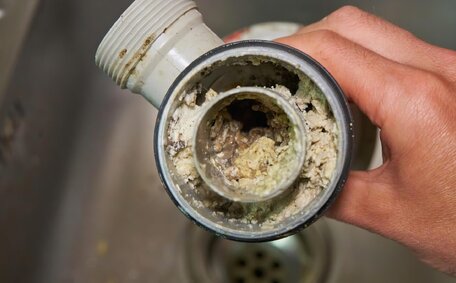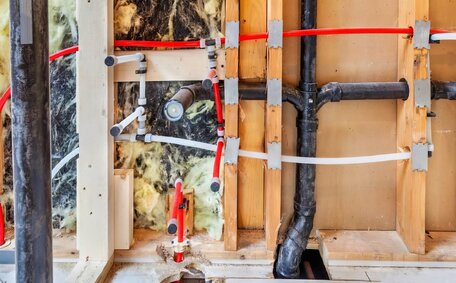Introduction to Gas Fitting in New Home Construction
Gas fitting is a critical component in new home construction, ensuring a safe and efficient supply of gas. Careful planning and expert installation ensures safe, reliable and efficient gas supply to power appliances and install gas heating and hot water. With the complexity of regulations, especially considering the potential gas ban in new developments, safety considerations and logistics, our new connection services provide an invaluable addition to your comprehensive plumbing needs.
This guide provides detailed insights for integrating gas systems into new construction, focusing on established best practices. Step-by-step guidance addresses service line connections to the gas network, metre box specifications and mandatory compliance paperwork. We also outline common troubleshooting issues when firing up appliances for the first time.
This guide covers crucial planning principles, from appliance selection to distribution layouts, including effective methods to request gas service connections.
As sustainability considerations grow, We’ll discuss efficient gas appliance options and the implications of a potential gas ban, as well as solar and electrical alternatives available to you. And most importantly, we detail the safety standards and certified tradespeople you’ll need to ensure when dealing with hazardous gas installations.
The Importance of Early Planning for Gas Connections
Incorporating our insights on gas connections into your building plans ensures a successful project with responsible gas utilisation. Selecting appliances and plotting internal pipe layouts early allows your builder to coordinate other structural, electrical and plumbing elements. Documented Service Diagrams then clearly specify connection points, line routes and metre positioning to gas authorities and contracted trade installers.
Early coordination also avoids potential compliance issues, streamlining the building process for the integration of existing gas systems in dwellings to ensure residential development constructions meet development control standards. Especially considering if there are any limitations regarding the distance between new gas connections and electrical assets, or other unsafe intersections from the banning gas under Australian Standard AS/NZS 5601. Proactive distribution mapping mitigates the expense of subsequent rectifications.
With a high number of new connections established in Victorian homes, planning ahead becomes essential to secure network capacity, especially with prospective bans on new gas installations. With expertise in industry requirements, our new connections team can help streamline processing lead times for complex multi-unit sites, reducing chances of supply delays if requirements are lodged with adequate time to drill service lines.
Submitting documents early, detailing predicted usage, load limits, and start-up dates, is critical to minimising post-construction service disruption.
Selecting Gas Appliances and Understanding Availability
Selecting the appropriate gas type for appliances and fittings, such as your hot water system, is a crucial step in new residential construction. Think about functionality, efficiency ratings, and which gas type is suitable for your abode when choosing cooktops, hot water heating systems, and space heaters.
Seek out new models with 5-6 star energy ratings that comply with Australia’s GEMS scheme, aiming for a notable reduction in emissions. Compare traditional gas hot water systems to electrical alternatives like heat pumps or solar systems. Review operating costs to potentially save money on your water supply, and assess the respective climate change impacts like greenhouse gas emissions across different energy options.
Additionally, confirm appliance availability promptly in the face of possible supply chain disruptions. Ensure you order new gas connection equipment at least 6-12 months in advance, sourcing from reputable manufacturers with local warehousing and established construction industry connections.
Consider future-proofing your home by selecting appliances with flexible positioning to allow for an easier transition to electricity, if needed. Solar Victoria offers grants to replace traditional heating hot water systems with electrical heat pumps in your home if it’s suitable.
you should contact your plumber or qualified gas fitters early regarding appliance selections based on your chosen gas type that’s most suited to your build’s layout and energy needs, ensuring you meet all safety standards.
Working with Builders to Coordinate Gas Fitting
Effective collaboration between builders and professional gasfitters ensures seamless network connections for residential gas resources in new builds. Open communication early on establishes clear roles and responsibilities for the design construction phase of your plumbing project.
Gasfitters provide specifications to assure the availability of gas at your site, detailing service line connections, appliance placement, and flue arrangements. They also recommend appropriate pipe sizing and layouts considering the site-specific conditions and construction plans. Builders need to coordinate effectively with gas fitters to integrate their work with the electrical, plumbing, and structural components of the construction process.
Organising plumbing works, like gasfitter site visits to establish gas connections new points and gas meter box locations, further facilitates the construction programme. Builders can then prepare ideal access routes for the gas line and anticipate potential clashes with other services.
Both parties maintain ongoing dialogue regarding equipment supply leadtimes, compliance documentation, and pre-commissioning safety checks. Excellent coordination minimises costly overruns and ensures households receive a safe, efficient your gas service.
Safety Regulations and Compliance Standards
Strict safety regulations and standards apply across every aspect of gas fitting to safeguard homeowners, tradespeople and the wider community.
Victoria’s state government requires that all gasfitting tasks adhere to AS/NZS 5601 Gas Installations and be conducted by a licensed gas fitter. Only licenced professionals registered with the Victorian Building Authority can design, install connected gas systems, size, test and commission them.
Installers must have police checks, relevant insurance, and comprehensive training in areas like explosion risk management and compliance documentation.
Following the latest codes of practice, which include employing licensed gas professionals, is essential for the safe operation of gas systems throughout their lifespan. The Victorian government’s advancement of net zero emissions targets to 2045 necessitates that the national construction code ensure gas pipes and appliances are sized correctly to prevent gas wastage and satisfy environmental objectives.
Certified gasfitters employ expertise to avert potential hazards and hidden problems. Detecting leaks, managing corrosion risks and locating lines all minimise the chance of dangerous errors.
Preparing the Site and Positioning the Gas Meter
Careful site preparation and strategic positioning are crucial for safe gas meter installation in new homes. Gas distributors perform site evaluations to identify the optimal meter location, conforming to clearance regulations.
Meters must be positioned away from potential hazards such as electrical boards, ignition sources, and plumbing drainage systems. Allowable proximity distances to these elements are covered under AS/NZS 5601 standards.
The area should enable easy access without obstructing household entryways or vehicle thoroughfares. Consider ease of future maintenance access too.
Positioning factors also include the length of piping runs to enter buildings safely below ground. Security measures like locked metre boxes may apply for units or townhouses.
After the gas distributor’s chief executive approves the position specifications including height, ventilation, and foundation, the builder prepares the site. This involves excavating to required depths, pouring concrete pads and installing protective metre boxes to standards.
With site works complete, your gas distributor schedules a distributor visit by qualified technicians to return and have the meter installed, connecting piping to the service line before commissioning the system.
Process for Installing Gas Meters and Making Connections
To install your gas connection meter and finalise connections, you need do as advised by the extensive planning and site preparation stages in the connection request form. The licensed gas fitter oversees the installation process in collaboration with local gas distribution authorities.
The distributor dispatches qualified technicians to conduct final inspections ensuring clearance specs, ventilation and foundation works meet compliance. Once the metre location is approved, technicians carefully connect gas to your appliances, service lines, and assemble piping up to the metre inlet.
Smart meters transmit usage data remotely, ensuring efficient monitoring. Mechanical dials require manual readings by the distributor. To secure the system, anti-tampering seals are applied prior to the activation of supply valves.
The gas fitter returns on-site to continue piping from the metre outlet to your gas appliance options via isolation valves. Leak testing using specialised equipment follows, with the fitter issuing a Certificate of Compliance and answering any questions upon successfully completing all safety checks and documentation.
Supply remains locked off during installation, prompting homeowners to find out more about their systems. The distributor performs one final inspection before arranging connection and account establishment with your energy retailer. Only then, no matter how protocols are confirmed with your gas retailer and checked on the Australian Energy Regulator website, is gas actively supplied to the appliances.
Trends Towards Electrification and Future Considerations
The plumbing industry is adapting to significant changes, including the forthcoming restrictions on gas connections and the transition to electrical alternatives that support emissions reduction targets. Victoria aims to implement a ban on new gas connections in homes by 2025, and some councils already mandate all-electric buildings, signalling a considerable turn in Australian energy policy.
While over 40% of Australian homes use natural gas, there is a growing trend towards energy-efficient alternatives, fuelling efforts to diversify the energy mix and curb greenhouse gas emissions. The shift from fossil gas to renewables such as solar aligns with the nation’s ambitions for net zero emissions. The enhanced efficiency of heat pump water heaters and induction cooktops offers viable alternatives for eco-conscious gas use.
For new homes connected to the gas network, optimized distribution pipes and device specifications are designed to reduce consumption. Mandatory solar installations help offset emissions across each state territory, integrating well with your water system needs. We also anticipate further incentives to foster branching out to new, alternative electrical models from governments and energy retailers alike.
Experts forecast that as electrification progresses, gas will be predominantly used in residential commercial sectors where electric solutions are not yet viable. Cost debates continue around running electrical cabling to replace gas pipes in established homes too.
Gas fitters may seek to upskill in electrical alternatives to adapt to dwindling residential demand. Or you can continue servicing the non-residential sector’s ongoing needs throughout this period of transition. Maintaining licencing and accreditation standards either way remains vital.






